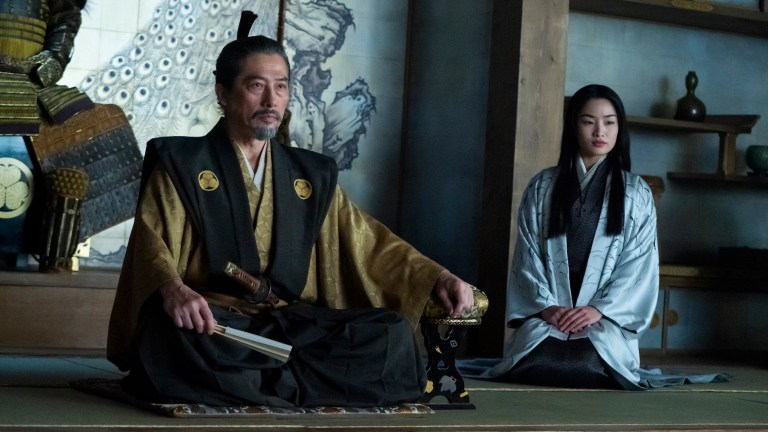Shogun’s Clever Approach to Japanese, English, and Portuguese Explained
Several languages are spoken in FX and Hulu's epic Shogun but viewers only ever hear two. Here's why.

This article contains spoilers for the first two episodes of Shogun.
Midway through its second episode, FX/Hulu miniseries Shōgun features a moment that could be rife with misunderstanding.
Pilot major John Blackthorne (Cosmo Jarvis) has unceremoniously washed ashore in Japan, becoming the first Englishman to do so. No one in Osaka speaks English, having just learned of England’s existence moments ago, so to communicate with this “barbarian,” powerful regent Lord Yoshii Toranaga (Hiroyuki Sanada) summons the closest thing to a Brit he can find to translate: a Portuguese Catholic priest named Father Martin Alvito (Tommy Bastow).
Since the Portuguese had previously established trade routes with feudal Japan, much of the Catholic clergy there can speak both Portuguese and Japanese. That’s how the scene unfolds then with Blackthorne speaking in his non-native Portuguese to Father Martin who then translates it in his non-native Japanese to Lord Toranaga who then must trust that he’s receiving the most accurate information possible with nothing important lost in translation.
Oh and did we mention that viewers never actually hear Portuguese? Blackthorne and Father Martin’s words are translated into English for the benefit of Shōgun‘s largely American audience. In fact, even though multiple languages are spoken throughout the series (including Dutch and maybe even Spanish), Shōgun watchers only ever hear English and Japanese. While that may sound confusing at first, Shōgun not only makes the language barriers work but also makes them sing.
Take, for instance, that aforementioned scene. Things get off to a choppy start with the Protestant Blackthorne expressing distrust that the Catholic will accurately translate his message. Father Martin puts those concerns to rest by giving Blackthorne the Japanese word for “enemy” so that he can point at Father Martin and declare him as such before Lord Toranaga.
“I may be your enemy, John Blackthorne of the Erasmus, but I am not your assassin,” Father Martin tells him.
As the scene continues, Father Martin’s translations slowly fade away in the audio feed and before viewers even realize it, Blackthorne and Toranaga are communicating directly with each other, having achieved the most important aspect of any linguistic exchange: trust.
Based on James Clavell’s classic 1975 novel (and its subsequent 1980 TV miniseries), this FX historical drama is a greatly ambitious undertaking. Clavell’s story is enormous, incorporating exhaustive research of feudal Japanese history into a spine-busting 1152 pages of narrative. Authenticity is the name of the game in any Shōgun adaptation. The folks behind FX’s Shōgun, led by showrunners Rachel Kondo and Justin Marks, have found a way to preserve that authenticity while still making the story accessible for Western TV audiences. And it all comes down to language.
In the first episode of FX’s official companion podcast for the series, Marks talks about the show’s shrewd use of languages and compared Blackthorne to his historical inspiration William Adams.
“[English] was sort of our lingua franca that we decided on early,” Marks said. “If you have European characters speaking, for the most part they’re speaking Portuguese. William Adams, historically, and John Blackthorne, the fictional character, both spoke a number of languages. It made sense that Portuguese could be his way of getting in with them.”
Podcast host and Shōgun writer Emily Yoshida also notes that the writers’ room for the series was made up of English-speakers. For the Japanese dialogue, the English scripts were sent to a team of translators in Tokyo who would translate the text into modern Japanese and then to a Japanese playwright specializing in history who would make the final product more appropriate for the time period. The English subtitles were translated from the this older version of Japanese spoken by the actors on the show, making the final English text frequently far different from what began on the page.
In episode 2 of the podcast, Kondo even recalls how this process frequently changed the language on the show for the better. At the end of episode one, Toranaga approaches Toda Mariko (Anna Sawai) to ask for her help in translating for the barbarian. He wants to know if she will feel conflicted about dealing with a heretic due to her Catholic fate.
“In the script [she responds] ‘it would be a problem if I was one thing,'” Kondo said. “It went to the Japanese and it came back ‘I have more than one heart.’ I thought that was a beautiful and much more spiritually accurate way to put it.”
It’s clear that Shōgun appreciates translation not solely as an obligation but as a creative opportunity.
The first two episodes of Shōgun are available to stream on Hulu now. Episodes premiere Tuesdays on Hulu and Tuesday nights at 10 p.m. ET on FX.
